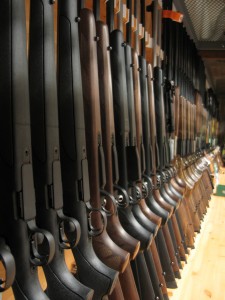ATF Bound Book:
1) Conduct a sample of 10% of your firearms inventory and match identifiers with entries in your A&D record.
One of the best methods used to assess the accuracy of your firearms log book is to take a sample of your firearms inventory and compare entries in the FFL log book to the actual firearms. There are actually a number of different ways in which to accomplish this type of examination.
ATF Bound Book: Let’s keep things simple.
Select a 10% sample of firearms in stock; estimates are fine.
Try to select a cross section of firearms. For example, select a number from firearms that have been in the store for a long period of time as well as some new arrivals. Select a sample of long guns and an approximately equal number of handguns.
Verify the firearms identifiers are entered correctly in the ATF bound book.
Keep in mind that firearms identifiers should be exactly correct. Abbreviations can be used, but stay away from abbreviations of manufacturers and models if at all possible. There is always a potential for violations to be issued if the writing is illegible or if improper abbreviations are used. Try to be as clear and clean as possible in your record keeping.
2) Take 10% of your ATF Forms 4473 and ensure that firearms identifiers match the entries in your AD record.
Select the ATF Form 4473 sample randomly, taking forms from different months going back for one year. If you have or had employees, select forms executed by employees you suspect are more prone to make errors and former employees, especially if they were terminated or left under other than ideal circumstances.
Examine the entries indicating the firearms transferred using the form and ensure they are complete. Compare the information with the information in the firearms logbook. Ensure the entries match exactly. Make sure the date of transfer matches as well.
3) Ensure any firearms that have been in inventory over 1 year are verified with your AD record.
It’s a good idea to keep close tabs on firearms that have been in inventory for a long period of time. Many times, firearms waiting on repair parts, frames, older guns that just to don’t sell, or even high end firearms that don’t move easily will just hang around for a long time in the store.
The problem lies in the fact the FFL will be confident the firearms are in the store, inside a drawer or container they’ve been in “forever”. Unfortunately, often the firearms are not where they should be for a number of good reasons.
However good the reason is, it won’t make a difference to ATF.
Make sure that those old, lingering firearms are accounted for, and don’t assume they are in “that container” because it’s where they’ve always been. Make sure!
4) Conduct a count of all firearms in stock and verify there are as many spaces in your A&D record (generally for gun stores with 300 or less firearms in stock).
Conduct a simple count of how many firearms are in your store and ensure there are an equal number of spaces indicating firearms in stock. This is only practical with small inventories of about 300 or less.
You’ll be surprised how this exercise usually turns out. It is highly likely that your count will be off. Don’t panic, there’s probably a good explanation as to why the count is off, especially by one or two firearms. However, if the count is 3 or more firearms off, you may actually have a problem with your inventory. Even if you are off by one or two guns, there may be a problem as well. The count should be dead on!
If the count is off, you should conduct a complete inventory by serial number to ensure no firearms are missing. If firearms are found to be missing, make a report to ATF immediately after you have determined that a firearm is not accounted for.
5) Examine your AD record for obvious errors:
Required entries left blank
Sloppy writing
Tick marks or lines instead of entries. Do not use tick or lines marks to indicate the information is “same as above”. Enter the information required accurately in each line of the ATF bound book.
If you have any FFL log books with a small number of firearms showing in stock, it’s a good idea to close those books out and archive them. Transfer the information to a book frequently used and indicate in the old book that the entry was transferred to the new book. There a a number of very good reasons for doing this, but essentially it’s a matter of organization and control of your inventory and records.

